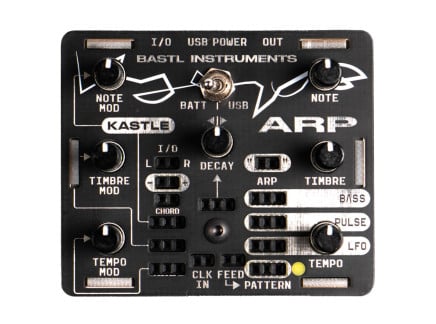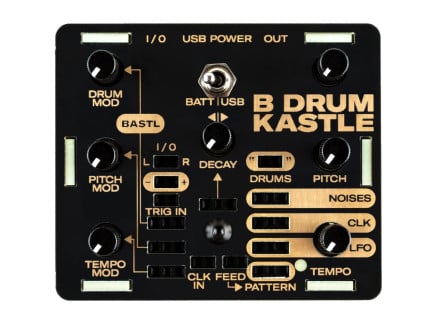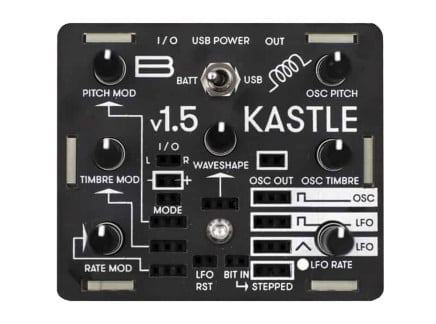Bastl has a unique way of infusing all of their designs with a unique flavor of fun—a sort of "f*** all the rules and just make some sound" approach which I, personally, find tremendously inspiring. This can be found across their entire product line, from the playfully-named Pizza complex oscillator to the Softpop 2 semi-modular synthesizer and beyond. They're all an outright blast to play...or, as a friend has commonly said, they're fun on a bun.
It is my perception that the public view of Bastl has shifted over the last several years, with many now thinking of them as being primarily a modular synthesizer company—and while they do make a number of excellent and inspiring Eurorack modules, they also have an extensive line of standalone boxes, many of which lean into delightfully lo-fi, quirky approaches to sound design and interaction. I'm thinking of the user-hackable Arduino/Mozzi-based Trinity series, the spectacularly glitchy MicroGranny, and—of course—the Kastle series.
The Kastle family is a group of pocket-sized semi-modular synthesizers designed to be portable and affordable. Each features an identical layout, using a digital sound engine and jumper-style patch connections to configure their behavior. You can think of them exactly like modular synthesizers that fit in the palm of your hand...making it easy to take your patching experiments wherever you go.
Each member of the Kastle family serves a different primary musical function. The Kastle V1.5 is a classic modular synth with digital waveshaping, an LFO, a pseudorandom voltage source, and three distinct sound generation modes. Kastle Drum is a miniature modular drum synth with an integrated pattern generator. And now, the newest member of the Kastle family is here: the Kastle ARP. Let's take a look at what it can do.
Bastl Kastle ARP Overview
Bastl's Kastle ARP is a handheld modular synthesizer tailored toward the creation of generative arpeggios, chord progressions, chiptune-style sonic chaos, and more. As with the other members of the Kastle family, it can be powered via USB or via 3x AA batteries. It uses breadboard jumper cables for internal patch connections, and includes the option to connect two external I/O channels (either input or output) to connect to your external modular or semi-modular gear. And of course, it has a headphone output, so you can easily take it with you and make music wherever you go.
While Kastle V1.5 is all about experimenting with different synthesis methods and Kastle Drum is all about rhythm generation, Kastle ARP instead turns its focus to the creation of generative arpeggios and chord progressions. It includes a digital sine wave oscillator, variable XOR waveshaping, a decay envelope, an LFO/clock generator, a stepped voltage generator, and a quantizer.
The basic idea behind Kastle ARP is this: there is a built-in quantizer that controls the pitch of the oscillator. You can select the specific note using the NOTE control, and you can modulate the currently selected pitch by using the NOTE MOD input and attenuator. Unlike most modular synths, the note control here isn't continuous: it's a quantized control, so NOTE jumps between specific, discrete pitches as you sweep the control. Each time it jumps to a new note, the internal decay envelope is triggered...so, you can produce arpeggios simply by turning the note knob alone. Of course, much of Kastle ARP's interesting behavior comes from using modulation to control the NOTE value—you can use the triangle LFO, for instance, to sweep up and down and created automated arpeggios at will.
[Above: detail images of the Bastl Kastle ARP.]
The quantizer itself has some other tricks, of course. By utilizing the CHORD CV inputs, you can alter the chord that the quantizer uses. By default, Kastle ARP uses a C major chord—if you connect the + output to the CHORD input, you can access the notes of a G major chord, and if you connect the - output to the CHORD input, you can access the notes of an F major chord. Dreamy, right? You can also use the Boot Mode to select different keys/chords, so you're not always locked into C major; pretty rad. By sending constant or fluctuating CV into the CHORD inputs, you can create automated chord progressions—arpeggios that evolve as predictably or unpredictably as you desire. The BASS output is a sine wave that's always at the root note of the selected chord, so it's possible to create simple harmonies as well.
The decay envelope has variable length. When turning the decay knob right from the center, you'll get notes that retrigger every time a new note is selected; when turning to the left, the envelope will only retrigger after the decay has dipped below a particular threshold. This means that it's possible to create patterns that skip notes by carefully tuning the timing of the NOTE CV source and the duration of the envelope.
Kastle ARP features a familiar pattern generator inspired by Rob Hordijk's Rungler concept: using a shift register to generate semi-predictable/semi-unpredictable voltage patterns. You can think of it like a pseudo-random sequencer—capable of altering any voltage-controllable aspect of the instrument. You could use it, for instance, to automate the chord selection, note selection, timbre, or even the rate of the LFO that triggers it—great for all manner of wacky behaviors.
Of course, as with any modular instrument, Kastle ARP is much more than the sum of its parts. These raw ingredients can be recombined in any number of ways—and you'll quickly find that it's every bit as capable of heavenly arpeggiated chord progressions as it is wild chiptune rhythms and all-out biting digital noise. It's a deceptively simple box capable of a huge range of sounds, and at the time of writing, it's only $118 USD. Frankly, that's a steal.
And of course, it pairs remarkably well with its siblings, Kastle V1.5 and Kastle Drum. Put them all together and you've got an arsenal of outrageously fun, lo-fi synthesizers with a level of flexibility and fun that can challenge even the most complex modular systems—all for under $400. Not too shabby. Whether you're looking for a first modular instrument, a way to dip your toes into synthesizers altogether, or just a new toy to add to your kit of sound-making oddities, Kastle ARP & its companions are a great way to go.













